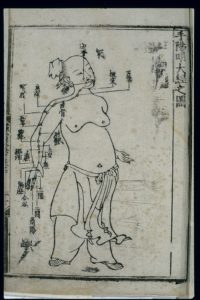Explanations of Channels and Points Vol.1 -Point Explanations I
______________________________________________

The following post is an excerpt from《Explanations of Channels and Points Vol. 1》 translated by Michael Brown and edited by Allen Tsaur. It explicates the origin of point names from a new perspective and viewpoint.
Large Intestine
Fifth Point of the Large Intestine Channel
Yáng Xī – Yáng Ravine (LI-5)
大腸經第五穴陽谿
注:腕之中横直有三穴,小腸經有陽谷,三焦經有陽池,大腸經爲陽谿,此取乎水行之義,以三穴皆自手腕而上行於臂之所也。
Explanation: the wrist crease has three points in it; the small intestine channel has Yáng Gǔ (SI-5), the sānjiāo channel has Yáng Chí (SJ-4), and the large intestine channel has Yáng Xī (LI-5). These [names] adopt the meaning of flowing water, because these three points are all in places where [they] depart from the wrist to ascend the arm.
氣血遇關節之所,必稍聚而後行,故以谷、池、谿名之。陽者,以陽明經也。三穴皆以陽稱,總爲陽經也。
When qì and blood encounter a joint, they must gather together briefly before progressing further; therefore, they are accordingly named valley,[1] pool,[2] and Xī (Ravine).[3] [It is named] Yáng because it is [located on] the yángmíng channel. These three points all also have Yáng in their name, [because they] are all on yáng channels.
Tenth Point of the Large Intestine Channel
Sān Lǐ – Three Lǐ (LI-10)
大腸經第十穴三里
注:足陽明經之在膝下也,有三里、上廉、下廉之穴,手陽明之在肘下也,亦有三里、上廉、下廉之穴,陽明同而經之性異。一與足太陰爲表裏,土也;一與手太陰爲表裏,金也。
Explanation: below the knee, the foot yángmíng channel has the points Sān Lǐ (ST-36), Shàng Lián (ST-37), and Xià Lián (ST-39); below the elbow, the hand yángmíng also has the points Sān Lǐ (LI-10), Shàng Lián (LI-9), Xià Lián (LI-8). They are identical as yángmíng; yet, the nature of the channels is different. [The foot yángmíng] together with the foot tàiyīn are an exterior-interior [pair], [they are] earth. [The hand yángmíng] together with the hand tàiyīn are an exterior-interior [pair], [they are] metal.
經之性不同,而何以穴之名同?豈以陽明之經爲氣血俱多之經,而胃與大腸所受水穀,獨異於他腑乎。不然,何其穴之名同也。
As the nature of the channels is different, then, why do these points have identical names? Isn’t it because [both] channels of yángmíng are channels that are copious in qì and blood, as stomach and large intestine both receive water and grain? Isn’t that uniquely different from other fǔ-bowels [pairs]? If not, then why would the names of the points be identical?
Fourteenth Point of the Large Intestine Channel
Bì Nào – Flesh of Upper Arm [4] (LI-14)
大腸經第十四穴臂臑
注:肘之裏肉曰臑,此穴在肘臑相交之處,故曰臂臑。本經肘之下,即有偏歷以爲絡,而通手太陰於肘之下,此穴又有絡,以通手太陰於肘之上。
Explanation: the interior flesh of the elbow is called Nào (Flesh [of the Upper Arm]), this point is located at the place where the elbow and upper arm intersect, therefore it is called Bì Nào (Flesh of the Upper Arm). Below the elbow on this channel, there is Piān Lì (LI-6), which is the network [point]that connects to the hand tàiyīn below the elbow. This point also has a network, which connects with the hand tàiyīn above the elbow.
手太陽之上肩也,自上循臑外廉,行手陽明、少陽之外,上肩循肩貞,却循後肩後行,無會本經之絡。
When the hand tàiyáng ascends the shoulder, it ascends along the outer ridge of the upper arm, on the outside of the hand yángmíng and the shàoyáng [channels]. It follows Jiān Zhēn (SI-9) to ascend the shoulder; however, as it follows behind the shoulder, it does not have a network-vessel to meet with this channel.
足太陽有别絡至肩,與陽維之會本經於此穴也。乃循脇肋斜上,肘上會手陽明、足太陽於臂臑者,而與本經會於此穴也。
The foot tàiyáng has a diverging network-vessel that reaches the shoulder, which along with the yángwéi [vessel] meets this channel at this point. [The yángwéi vessel] follows the flank and rib-sides to ascends obliquely, and meets the hand yángmíng and foot tàiyáng [channels] at Bì Nào (Flesh of the Upper Arm) above the elbow; it meets with this channel at this point.
Eighteenth Point of the Large Intestine Channel
Fú Tú – Assisting Chimney[5] (LI-18)
大腸經第十八穴扶突
注:突者,通氣之名,在任經之在喉者有天突,在胃經之在於其旁者有水突,以咽水榖而有名也。水突之旁,又在其後者,則曰扶突,乃以水突、天突而得名也。
Explanation: Tú (Chimney) is the name for that which the qì flows through. On the throat, on the rèn channel, there is Tiān Tú (REN-22); on its side, on the stomach channel, there is Shuǐ Tú (ST-10), which is so-named because water and food are swallowed here. To the side of Shuǐ Tú (ST-10), also located behind it, this [point] is called Fú Tú (Assisting Chimney). It is named so because of Shuǐ Tú (ST-10) and Tiān Tú (REN-22).
Twentieth Point of the Large Intestine Channel
Yíng Xiāng – Welcome Fragrance (LI-20)
大腸經第二十穴迎香
注:迎香以鼻聞香臭而得名也。本經於此穴而上交於足陽明也。
Explanation: [this point] obtained its name Yíng Xiāng (Welcome Fragrance) because the nose smells all types of odours. The channel ascends from this point to intersect with the foot yángmíng [channel].
[1] Gǔ 谷 (Valley) as in Xiàn Gǔ (ST-43), Qián Gǔ (SI-2), Yáng Gǔ (SI-5), Rán Gǔ (KI-2), and Yīn Gǔ (KI-10).
[2] Chí 池 (Pool) as in points Qū Chí (LI-11) and Yáng Chí (SJ-4).
[3] Xī 谿 (Ravine) as in points Jiě Xī (ST-41), Hòu Xī (SI-3), Taì Xī (KI-3) and Xiá Xī (GB-43).
[4] Grasping the Wind names it “Upper Arm.”
[5] Grasping the Wind names it “Protuberance Assistant.”
_____________________________________
Post-Scriptum: The book is available on amazon.com under the following link:
https://www.amazon.com/Explanations-C…/…/ref=sxts_sxwds-bia…
PPS: Vol. 2 will be released next year.
PPS: The images come from the wellcome collection.
If you enjoyed reading this please consider supporting us!
When we started the Purple Cloud Institute, our aim was to make accessible educational material about traditional Chinese cultural practices. We strive to keep prices of our books as affordable as possible and the content we provide free of charge. However, there are many ongoing behind the scenes costs and the time taken to provide such content is considerable.
If you have enjoyed our offerings please consider donating and supporting us. The help will allow us to make time to bring you more in the way of book publications, podcasts and videos about tradition-based Daoist, Chinese medicine and martial arts and help keep these traditions alive.
Your assistance is greatly appreciated!
